Vanillekipferl (Austrian Vanilla Crescent Cookies)
This post may contain affiliate links. See my disclosure policy.
Buttery, vanilla-infused and delicately crumbly with an almost melt-in-your-mouth texture, these Austrian vanilla crescent cookies will thoroughly win you over! A traditional Vanillekipferl recipe, the way my Oma and Mutti made them!
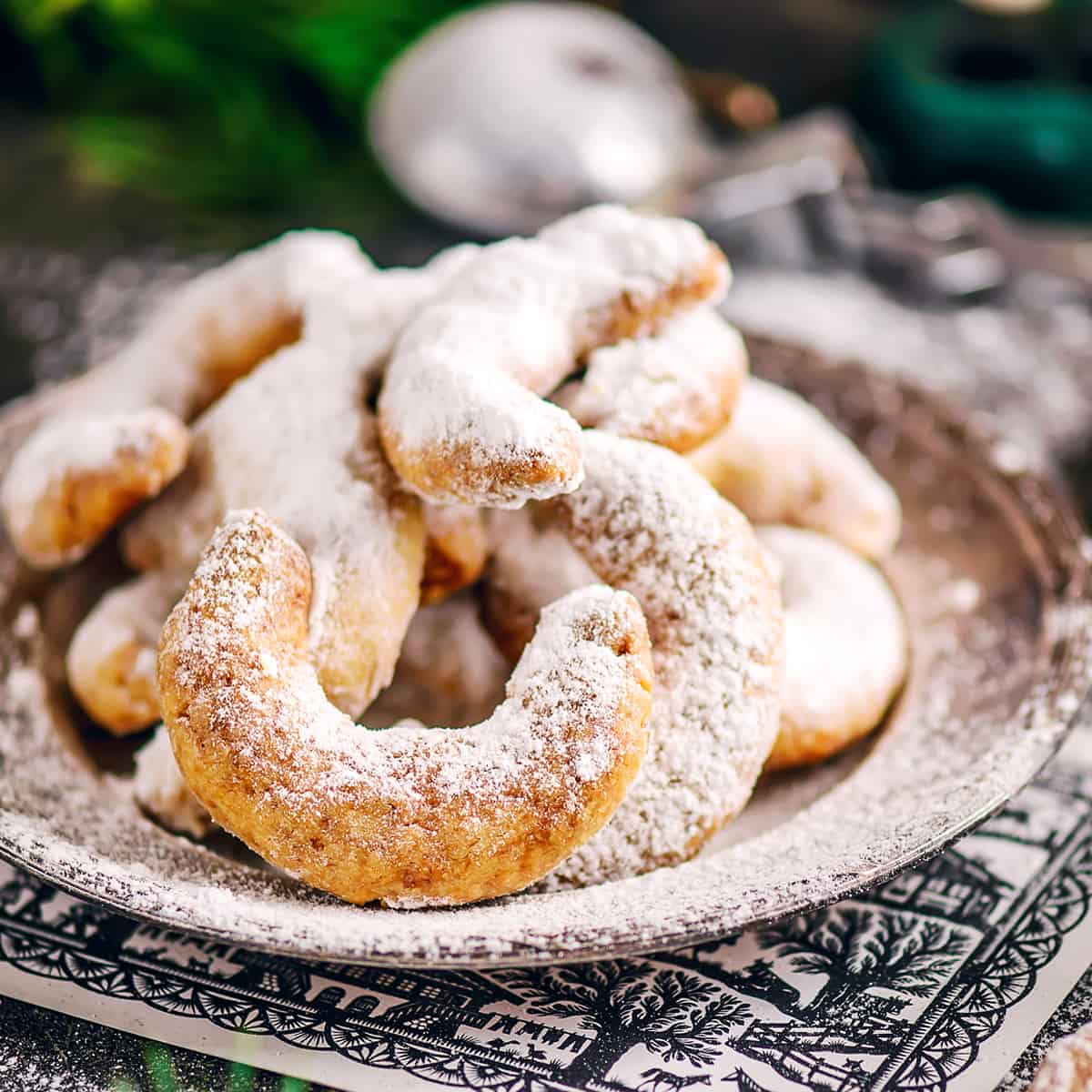
What Are Vanillekipferl?
Vanillekipferl are vanilla-flavored crescent-shaped shortbread cookies made with ground nuts – traditionally walnuts but also hazelnuts or almonds – and generously dusted with vanilla sugar. They owe their delicately crumbly, melt-in-your-mouth texture to the high butter content and the absence of egg. Popular throughout Austria, Germany, the Czech Republic, Poland, Slovakia and Hungary, these cookies are enjoyed year-round and can be found in virtually every Viennese coffee house. But these cookies are especially popular at Christmastime. I have fond memories of munching on these crumbly cookies while walking around the Vienna Christmas market as a child and then later on as an adult. The experience of savoring traditional Austrian pastries on location in that magical Christmas atmosphere is one that’s not to be missed if you ever get the chance.
Growing up in Germany, we made these every year at Christmas along with our other favorite traditional Christmas goodies. Christmas in Germany and Austria without Vanillekipferl is practically unthinkable! And I’ve kept that tradition going since moving to the United States.
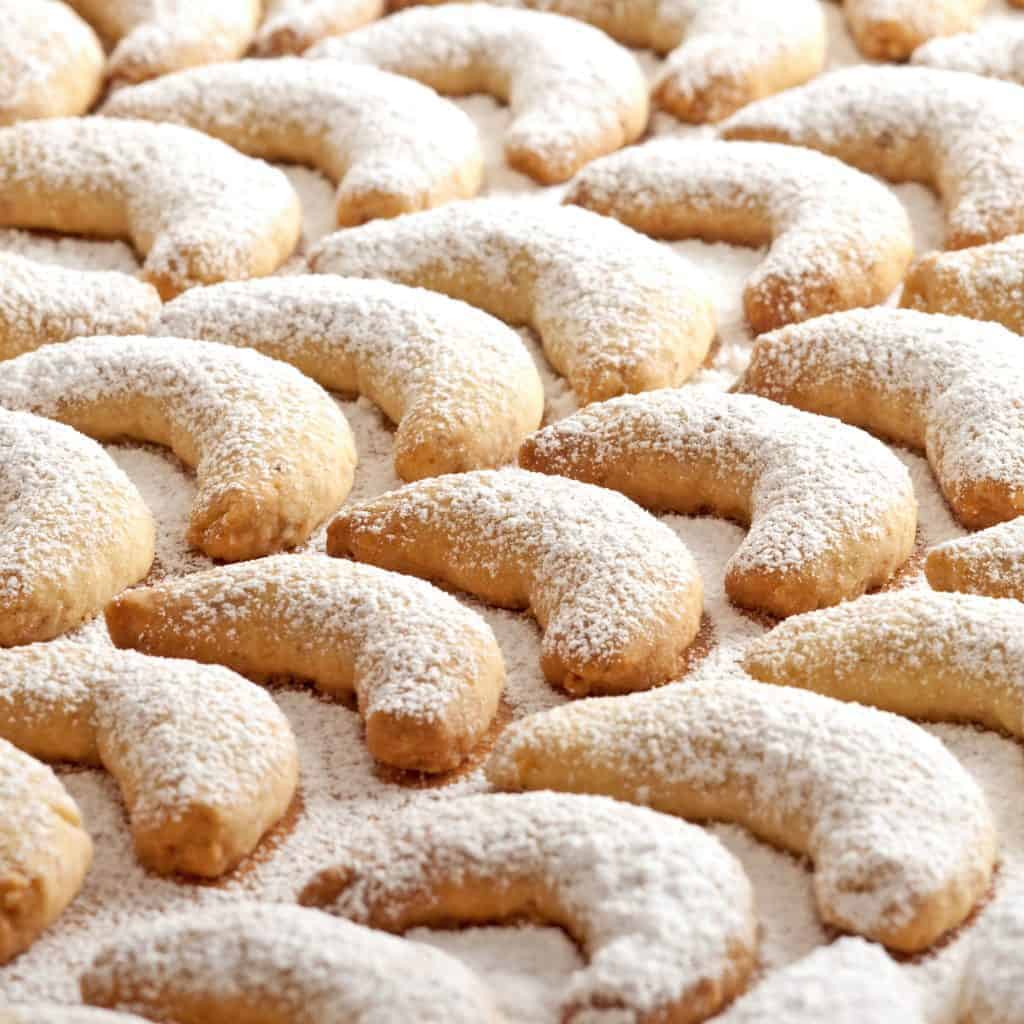
Where Did They Originate?
Though popular throughout much of Europe, Vanillekipferl originated in Vienna, Austria around 400 years ago when, in celebration of a victory over the Ottoman Turks, the locals created this pastry in the shape of the crescent moon (“kipferl”) found on the Turkish banner.
In the ongoing wars with the Turks, the Austrians came up with additional crescent-shaped pastries, the most famous of which eventually made its way to France where it was popularized. Any guesses? The croissant. Yes, we owe the croissant to none other than Austria!

Traditionally Vanillekipferl are made with ground walnuts which result in a moister texture, but ground almonds or hazelnuts can also be used. Ground blanched almonds will result in a light-colored cookie whereas ground walnuts and hazelnuts will result in a darker, speckled cookie. They’re all delicious – take your pick!
As already mentioned, these are shortbread cookies and as such no eggs are included (think traditional Scottish shortbread). And though you’ll find some Vanillekipferl recipes that call for eggs, eggs are not traditionally included. Yes, adding an egg will make the dough easier to work with (it’s softer and more pliable), but resist the temptation to do so because you’ll find that working through the drier, flakier shortbread dough is more than worth it in order to experience that heavenly, delicately crumbly, melt-in-your-mouth texture!
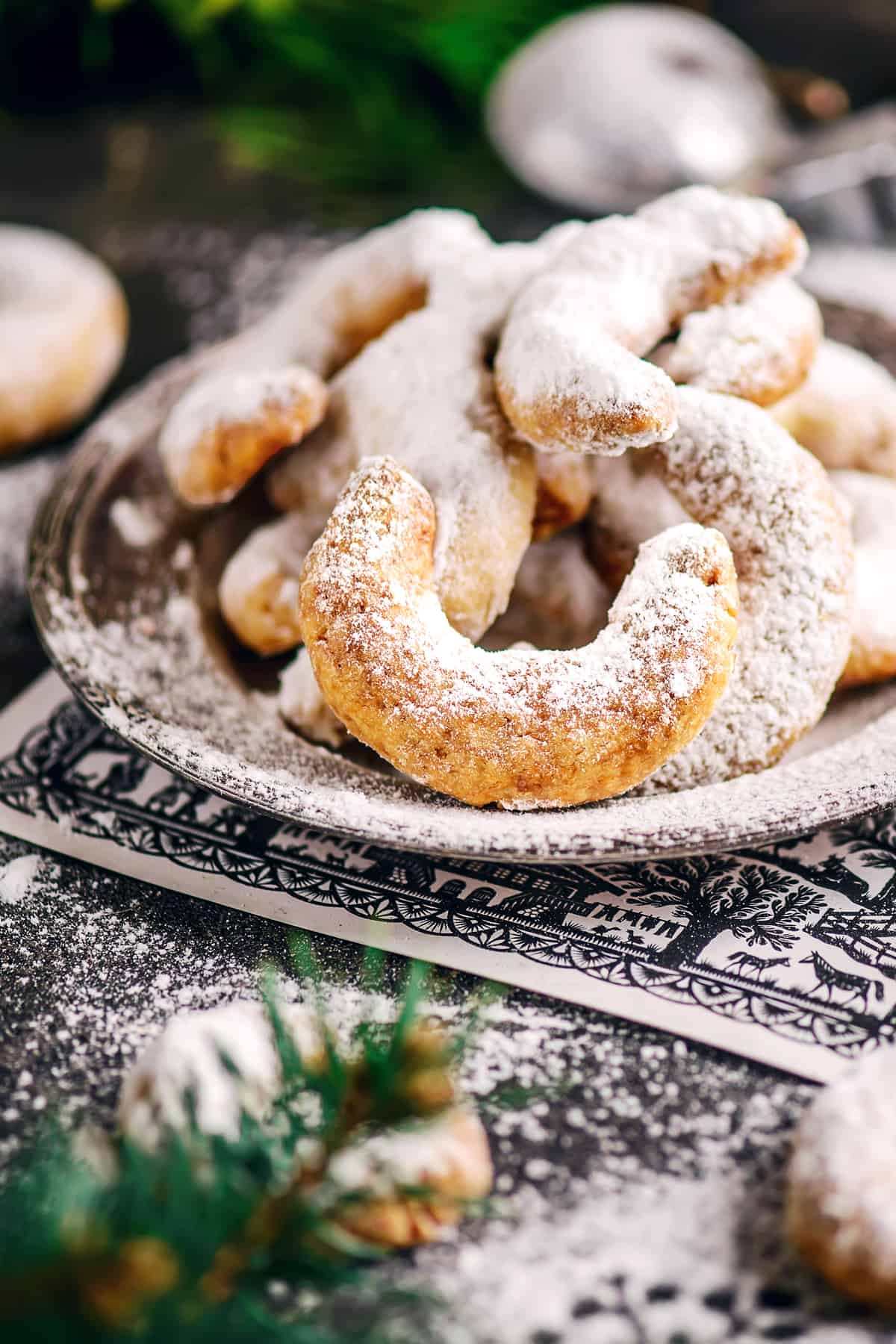
Tips for Making Vanillekipferl
- Almond meal comes both blanched and non-blanched and you can use either. If you prefer “white” vanillekipferl use the former, if you like them speckled, use the latter.
- Traditional Vanillekipferl are made without eggs. Similar to Heidesand and Scottish shortbread, Vanillekipferl are a shortbread-like cookie that should have a very delicate, crumbly, almost melt-in-your-mouth texture. Adding eggs will make the dough easier to work with (there is something of a learning curve to this kind of cookie dough), something to consider if you’re a beginning baker. Otherwise I strongly recommend omitting the eggs so you can enjoy the fabulous texture of these cookies.
- If you can splurge, use the best butter you can find. These cookies are made with few and simple ingredients and so quality is key.
- Don’t take out all of the dough from the refrigerator at once; depending on how quickly you work, take out half or a third of the dough at a time to form the crescents while the remaining dough stays cold in the fridge.
- Make sure the crescents are uniform in size so that they bake evenly.
- Avoid making the ends of the crescents too skinny or they may burn during baking.
- Some bakers roll the cooled crescents in a bowl of confectioner’s sugar while others lay them out and use a sifter to dust them. This is purely a matter of personal preference. While they’ll initially look prettier with a dusting, once they’re stacked in the storage tin it won’t matter.
- The flavor of Vanillekipferl improves with time. As good as they are fresh out of the oven, keep them stored in an airtight tin/container for a few days before eating them to experience the improvement in flavor. Stored properly, Vanillekipferl will keep for up to a month. However, if you use eggs they will only keep for up to one week.
Vanillekipferl Recipe
Let’s get started!
Place all of the ingredients in a large bowl and knead until thoroughly combined. The dough will be fairly dry and flaky.

Preheat the oven to 350 degrees F.
Shape the dough into a log and wrap with plastic wrap. Chill in the refrigerator for at least an hour.
Take some of the dough out of the fridge, leaving the remaining dough wrapped in the fridge to stay cold. Cut off small pieces of the dough and shape them into crescents. It’s usually easiest to shape them into crescents on the cookie sheet but some people find it easier to shape them in their hands. Do whichever works for you. Shape them into uniform sizes so they bake evenly.
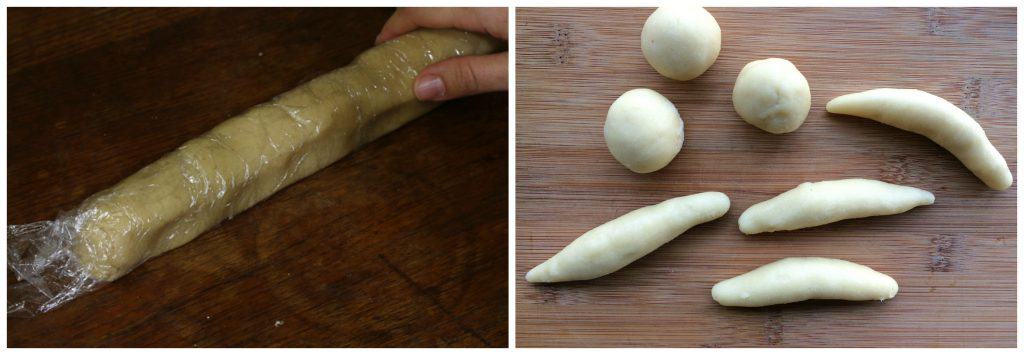
Place the cookies a non-stick or parchment-lined cookie sheet.
Bake on the middle rack for 12-15 minutes (depending on the size of the crescents) or until the edges begin to turn golden.
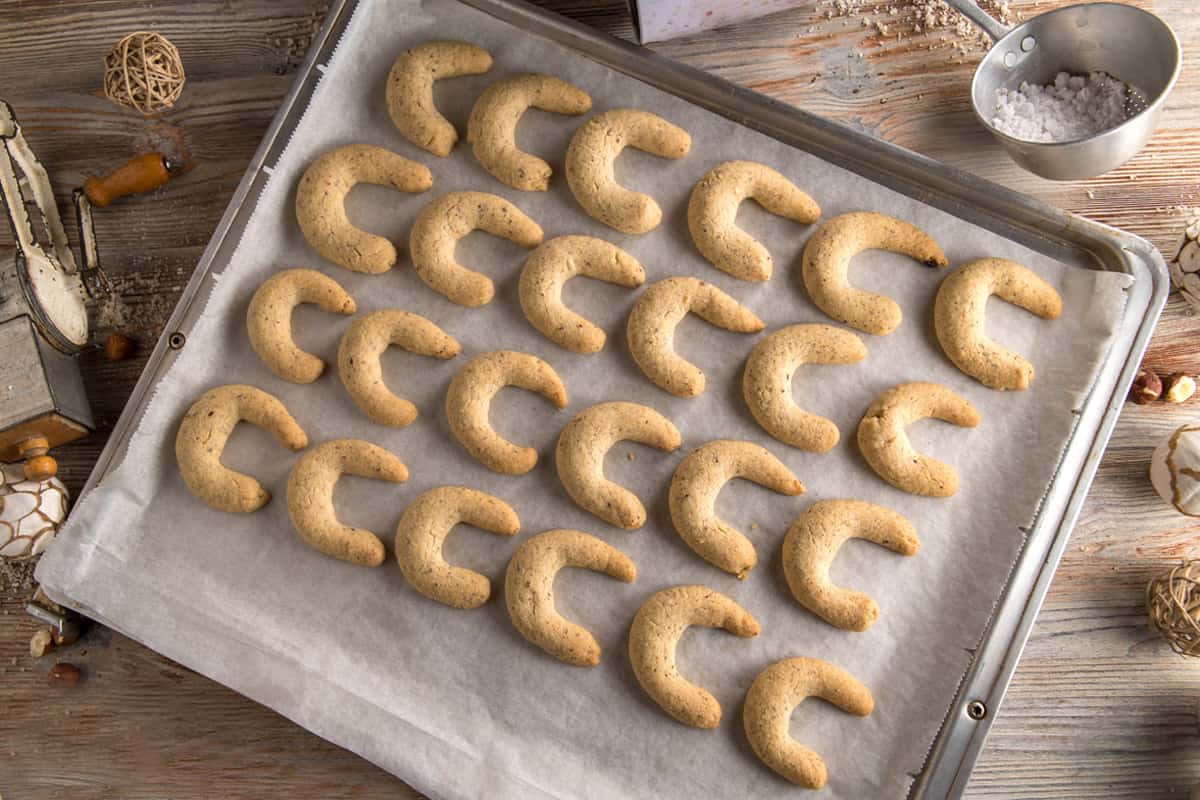
Combine the powdered sugar and the vanilla sugar. You can buy vanilla sugar here.
Or you can make your own vanilla sugar. To make vanilla sugar you simply place vanilla beans in a container or ziploc bag of white granulated sugar. Seal shut and let it sit a few weeks, shaking occasionally. Discard the vanilla beans – your vanilla sugar is ready to use! How many vanilla beans you use depends on how strong you want the flavor and how much sugar you’re making. I make my own homemade vanilla extract and use those beans to make sugar – it’s a great way to make double use of the beans (I explain it further in my homemade vanilla extract post).
Let the cookies sit for one minute and then use a sifter to dust them with the vanilla-powdered sugar while they’re still hot.
Let the cookies cool completely and then give them a second dusting.
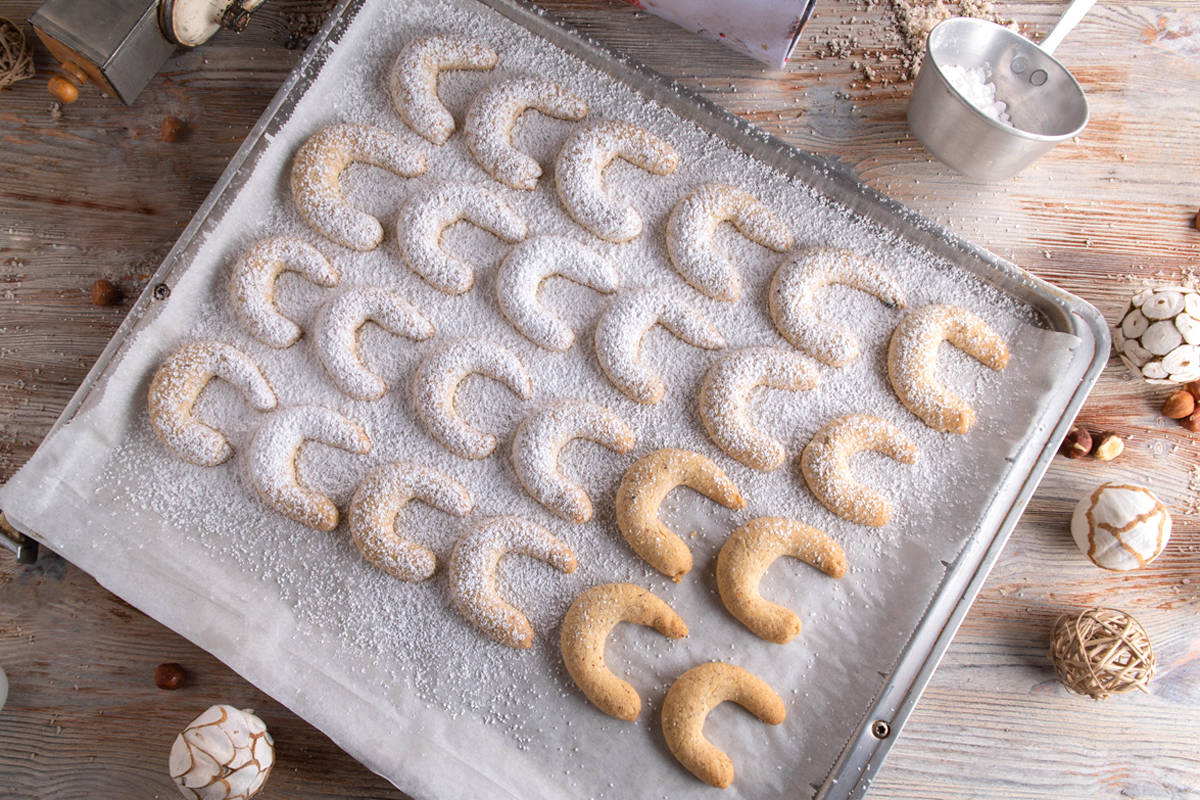
Stored in an airtight container in a cool place, these cookies will keep for several weeks.
Be sure to check out all of my favorite traditional German Christmas Cookies!
Enjoy!

For more traditional Austrian and German Christmas favorites try my:
- Gugelhupf
- Zimtsterne
- Pfeffernüsse
- Lebkuchen
- Stollen
- Apfelstrudel
- Springerle
- Engelsaugen
- Kaiserschmarrn
- Germknödel
- Spitzbuben
- Printen
- Speculoos Cookies
- Magenbrot
- Bethmännchen
- Heidesand
- Marzipan
Save This Recipe
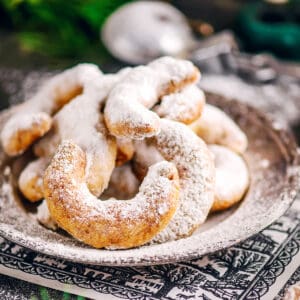
Vanillekipferl (Austrian Vanilla Crescent Cookies)
Ingredients
- 2 cups all-purpose flour
- 1 cup unsalted butter , softened at room temperature
- 2 large egg yolks (optional but not recommended) (egg is not traditional but for beginning bakers makes the dough easier to work with; see Note)
- 4 ounces (about 1 cup) either walnut, almond, or hazelnut flour
- 1 packet vanilla sugar (about 1 1/2 teaspoons)
- (see pictured instructions in post on how to make your own vanilla sugar)
- 3/4 cup powdered/confectioner sugar
- 1/4 teaspoon salt
- For Dusting:
- 1/2 cup powdered/confectioner sugar
- 1 packet vanilla sugar (about 1 1/2 teaspoons)
Instructions
- Place all of the ingredients in a large bowl and knead until thoroughly combined. Unless you're using the egg yolks the dough will be pretty dry and flaky, like shortbread cookie dough. Shape the dough into a log and wrap with plastic wrap. Chill in the refrigerator for at least an hour.
- Preheat the oven to 350 degrees F.Take some of the dough out of the fridge, leaving the remaining dough wrapped in the fridge to stay cold. Cut off small pieces of the dough and shape them into crescents. Shape them into uniform sizes so they bake evenly. Place the crescents onto a non-stick or parchment-lined cookie sheet. Bake on the middle rack for 12-15 minutes (depending on the size of the crescents) or until the edges begin to turn golden.
- Combine the powdered sugar and vanilla sugar. Let the cookies sit for one minute and then use a sifter to dust them with the vanilla-powdered sugar while they're still hot. Let the cookies cool completely and then give them a second dusting.Store the cookies in an airtight container in a cool place (not the fridge) and these cookies will keep for 3-4 weeks (1 week if using egg).
Notes
Nutrition
Originally published on The Daring Gourmet October 26, 2017



















It was so interesting to discover the history of this cookie! I’ve been making something very similar for years (actually decades) but with pecans, no vanilla, and rolled in plain powdered sugar. They are definitely a family and friend favorite—a “must” for the holiday season! I had originally discovered the recipe in a collection called “Five-Star Favorites: Recipes From Friends of Mamie and Ike” (yes, the Eisenhowers) which has recipes by their celebrity friends of the mid-20th century. The recipe for Pecan Crescents was attributed to the ambassador to Belgium, but now I know the real story! The proportions are just slightly different–a lot more nuts and a lot less sugar in the cookie, but probably end up with more sugar on the outside so overall it’s probably about the same: 2-1/4 c. flour, 1 c. unsalted* butter, 1-1/2 c. finely chopped pecans (I start with whole or halves and then use food processor, as they have better flavor than pre-chopped), 1/4 c. sugar, 1/2 t. salt*, 1/4 t. baking powder, confectioner’s sugar (for rolling the cookies in after they have cooled, probably about half a bag; some people like it simply without the confectioner’s sugar, as a more savory option). Oven temp and cooking time–350 degrees for 12-15 min.–are the same as for Vanillekipferl recipe here. And no eggs. No vanilla either, but the flavor of the pecans is enough. Simply the best!!!
*I usually use salted butter and then cut back slightly on the salt. I’ve tried it with unsalted butter and then adding salt, but I must like extra salt because I prefer it with salted butter!
I’m glad you enjoyed the read, Monique! The cookbook you mentioned sounds super fun and I just ordered a copy – thank you! :)
This recipe worked wonderfully using one egg yolk. I measured/weighed the ingredients very carefully. I had the easiest time ever shaping pretzels. They were perfect, with no spreading during baking. I hope I am as successful in subsequent endeavors using this recipe.
Fantastic, Jyl, thank you so much for the feedback!
Thank you very much for giving me the recipe that my mother did not leave me. I lived in Vienna most of my life before living in Africa for 20 years thereon. Looking at the Vanillekipferl, I can almost smell the vanilla;my mother used to place the Kipferl in jar with Vanilla sticks just to preserve the flavour. What a pleasure to be able to now hopefully bake these for the family.
Hi Toby, I have a similar experience, living in Florida since 25 years. Now I am 70. I cook daily but hardly ever bake. I found this recipe which is similar to my Donauland Kochbuch recipe. I will prepare some this week, for the first time since I am here. Should not have forgotten it.
Well I’m hoping that you’re still online to see my comments. I made the original recipe That you posted, without eggs It was perfect I had to use my hands to mix everything as it should be and I made sure everything was very well mixed before I made the logs of cookies to put into the refrigerator.
My husband is first generation here in United States
His family had to leave Vienna because of Hitler
The best memories that he had wiere his Tanta Elsa’s Kipferl
Success
Later when we found one of his grandmother’s sisters that did survive from Austria her recipe was very close to yours in fact perfectly so
and GuessWhat no eggs
The difference was how they ground the nuts sometimes there is a larger pieces but it was a perfect recipe I want to thank you again it made him very very happy and perfection I now make them all the time.
I am now I’m going to make my own vanilla extract thanks to you and my vanilla sugar which will only make them more perfect.
I am happy to send you a photo copy of the original recipe If my husband will allow 🤭😁 but from my understanding it was written down for the daughters of this woman to come before I believe the First World War
And that to me is even more amazing so again thank you for your patience to try to pass this on to us I’m writing this because I found you online to see how close his family‘s recipe came to yours amazing exactly
Thank you so much for your detailed feedback and kind words, Elaine, I really appreciate it :) Yes, a photo copy of that old family recipe would be great, thank you. You can email it to me at daringgourmet@yahoo.com. Thanks again and I’m happy you found my site!
I’m wondering whether or not I can freeze the dough for a few days, as I want to make them ahead of time. Before baking should I defrost them and bake for the original 12-15 minutes? Or should I bake from frozen for a bit longer?
Awesome recipe! I tried it today – I am missing Austrian Christmas time, and my favorite biscuit – and it brought back amazing memories!
Francois
I’m so glad you enjoyed it, Francois, thank you!
Amazing recipe!!! Thank you, this recipe brings me back to my childhood in Germany.
Wonderful, Siggy, thanks so much!
Another classic recipe. So glad I’ve found this site. My Oma‘s Vanillekipferl and other Kipferl type cookies also have no eggs. A tricker dough to shape, light fingers are needed, and the reward is a wonderfully textured cookie. Danke Kimberly.
Thank you, Aleksandra, I’m so glad you found us too and as always I appreciate your feedback! :)